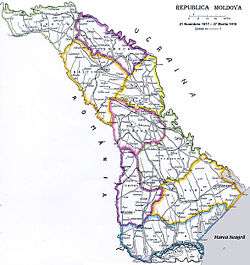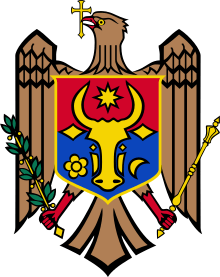Moldavian Democratic Republic
| Moldavian Democratic Republic | ||||||||||
| Republica Democratică Moldovenească | ||||||||||
| ||||||||||
| ||||||||||
 Map of the Moldavian Democratic Republic | ||||||||||
| Capital | Chișinău | |||||||||
| Languages | Romanian | |||||||||
| Government | Republic | |||||||||
| President | ||||||||||
| • | 1917–1918 | Ion Inculeț | ||||||||
| Legislature | Sfatul Țării | |||||||||
| Historical era | World War I | |||||||||
| • | Established | 15 December [O.S. 2 December] 1917a | ||||||||
| • | Independence | 6 February [O.S. 24 January] 1918 | ||||||||
| • | United with Romania | 9 April [O.S. 27 March] 1918 | ||||||||
| ||||||||||
| Today part of | | |||||||||
| a. | See Old Style and New Style dates. | |||||||||

Part of a series on the |
|---|
| History of Moldova |
 |
|
|
The Moldavian Democratic Republic (Romanian: Republica Democratică Moldovenească), also known as the Moldavian Republic, was a state proclaimed on December 15 [O.S. December 2] 1917 by the Sfatul Țării (National Council) of Bessarabia, elected in October–November 1917 following the February Revolution and the start of the disintegration of the Russian Empire.
The Sfatul Țării was its legislative body, while the "Council of Directors General", renamed the "Council of Ministers" after the Declaration of Independence, was its government.
History
When the February Revolution occurred in Petrograd in 1917, the governor of the Bessarabia Governorate stepped down and passed his legal powers to Constantin Mimi, the President of the Gubernial Zemstvo, which was named the Commissar of the Provisional Government in Bessarabia, with Vladimir Criste his deputy. Similar procedures took place in all regions of the Russian Empire: the chiefs of the Tsarist administrations passed their legal powers to the chiefs of the County and Governorate Zemstvos, which were then called County/Governorate Commissars.[1]
The Peasants' Congress, which took place in October 1917, voted Mimi out and Ion Inculeț in as the new Commissar. This move was planned by Alexander Kerenski, who sent Inculeț, an associate professor at the University of Petrograd, to Bessarabia to take hold of the situation. As soon as the Peasants' Congress, which had no legal power, voted, Kerenski formally replaced Mimi with Inculeț. When Inculeț arrived in Chișinău to take power, he faced the quiet opposition of the nobility, so he agreed to take the position of deputy commissar to Vladimir Criste. When the republic was proclaimed, Criste stepped down and passed his legal powers to Inculeț.[1]
The Sfatul Țării (National Council) of Bessarabia was elected in October–November 1917, and started to work in December 1917. It proclaimed the Moldavian Democratic Republic as a federal subject (autonomous republic) of the Russian Democratic Federative Republic.[2]
In the context of the October Revolution, the Russian Army on the Romanian Front disintegrated. The large number of retreating soldiers increased the level of anarchy in Bessarabia, leaving the National Council with only minimal authority over the territory. To further complicate matters, as the Council was delaying a decision on the agrarian question, peasants across the region started to break up the estates of the large landowners and divide them among themselves. As the General Staff of the Romanian Front was unable to send any troops, attempts were made to organize a Moldavian National Guard, but the results were far from expectations. Furthermore, most of the army corps nominally subjected to the National Council came under Bolshevik influence. However, in mid-January Romanians entered the country, engaged in battles with the Moldavian and Bolshevik troops and within a couple of weeks controlled much of the country.[3]
Following the signing of separate peace armistices by Imperial Germany with Romania, Ukraine and Bolshevik Russia the Sfatul Țării, with 86 votes in favour, 3 against and 36 abstentions, proclaimed the Union of Bessarabia with the Kingdom of Romania on April 9 [O.S. March 27] 1918, with the condition of local autonomy and the continuation of Bessarabian legislative and executive bodies, legally ending the Moldavian Democratic Republic. Discouraged by the fact that the Romanian troops were already present in Chișinău, many minority deputies abstained from voting.[4][5]
The union was confirmed in the Treaty of Paris (1920).
Leadership
The leadership of the Moldavian Republic was composed of Ion Inculeț, the president of the Sfatul Țării and President of the Republic; and Pantelimon Erhan, the President of the Council of Directors General. The new leadership and Council was put in place after the country was declared independence by Daniil Ciugureanu, as President of the Council of Ministers. The Sfatul Țării was initially composed of 120 elected members, although member numbers were later increased to 135 and then 150. For example, on 9 April, there were 138 legislators, of which 125 took part in the vote, and 13 were absent.
On December 21 [O.S. December 8] 1917, the Sfatul Țării elected the government of the Moldavian Democratic Republic - the Council of Directors General, with nine members, seven Moldavians, one Ukrainian, and one Jew:
- Pantelimon Erhan, President of the Council, and Director General for Agriculture.
- Vladimir Criste, Director General for Internal Affairs.
- Ștefan Ciobanu, Director General for Education.
- Teofil Ioncu, Director General for Finance.
- Nicolae N. Codreanu, Director General for Railways.
- Major Teodor Cojocaru, Director General for Armed Forces.
- Mihail Savenco, Director General for Justice.
- E. Grinfeld, Director General for Industry and Trade.
- Ion Pelivan, Director General for Foreign Affairs.
In its first decree, the Council set forward the aim to "introduce order in all the aspects of life of the country, to eliminate anarchy and disaster, to organize all the aspects of state administration". An Executive Clerk Office (Cancelarie) of the Council of Directors General was set up, and all state, public and private institutions were required to communicate through the Executive Clerk Office to the corresponding Director General for all questions regarding the government of the country. All acts in the domain of public administration made without the previous consent of the respective Directors General were declared legally void, while the director freed from responsibility for such acts.[6]
See also
- Union of Bessarabia with Romania
- Soviet occupation of Bessarabia and Northern Bukovina
- Russian Revolution of 1917
- Odessa Soviet Republic
- Iona Yakir
Gallery
 Declaration of the Moldovan People's Republic.
Declaration of the Moldovan People's Republic.%2C_President_of_Moldavian_Democratic_Republic.jpg) President Ion Inculeț.
President Ion Inculeț.


.jpg) Dimitrie Bogos, chief of the General Staff of the Army.
Dimitrie Bogos, chief of the General Staff of the Army.%2C_Prime_Minister_of_Moldova.jpg)
.jpg) Teofil Ioncu, Director General for Finance.
Teofil Ioncu, Director General for Finance..jpg) Gherman Pântea, Director General for Armed Forces.
Gherman Pântea, Director General for Armed Forces.
References
| Wikimedia Commons has media related to Moldavian Democratic Republic. |
- 1 2 Ion Nistor, p. 279
- ↑ Michael Bruchis (1996). The Republic of Moldavia: from the collapse of the Soviet empire to the restoration of the Russian empire.
- ↑ van Meurs, Wim, The Bessarabian question in communist historiography, East European Monographs, 1994, p. 65
- ↑ Cristina Petrescu, "Contrasting/Conflicting Identities:Bessarabians, Romanians, Moldovans" in Nation-Building and Contested Identities, Polirom, 2001, pg. 156
- ↑ King, C. The Moldovans: Romania, Russia and the Politics of Culture, Hoover Institution Press, 2000, pg. 35
- ↑ Halipa, Moraru, p.74-75


